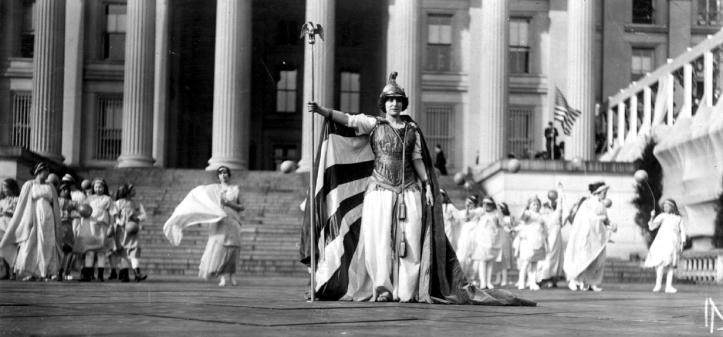
The Origins of the Women’s Suffrage Movement
The idea of “waves” in feminism was first coined by Martha Weinman Lear in her March 1968 article for The New York Times Magazine, titled “The Second Feminist Wave.” In that article, she identified the first as well as the second wave: the first wave is the fight for legal enfranchisement—suffrage—and the second, concurrent with the “women’s liberation” movement of the 1960s, is the fight for social equality. Lear’s coinage has become the standard taxonomy of feminism, and we are arguably regarded to be experiencing the fourth wave now. Each wave builds on the progress of, and in some cases challenges the tenets of, the previous waves.

The suffragettes (in England) and suffragists (in the United States) of the mid 19th and early 20th century are the vanguard of the first wave—but, of course, women were crying out for their rights from the first moment they were denied them, and writing manifestos against misogyny from the moment they could put quill to paper. Sor Juana Inés de la Cruz, a Mexican nun and poet, argued for women’s rights in the pre-Enlightenment 17th century. Christine de Pizan challenged misogyny even earlier, in the medieval era. Identified by Simone de Beauvoir in her important work The Second Sex as the first woman to write about women’s issues, Pizan’s work is now widely considered the origin point of the fight for women’s equality.
But Pizan is not considered the grandmother of feminism’s first wave. That would be Mary Wollstonecraft, whose A Vindication of the Rights of Woman, published in 1792, eventually catalyzed hundreds of years of women’s thought and struggle into a coherent movement for voting rights in both England and the United States. In the Vindication, Wollstonecraft takes Enlightenment ideas and expands them to include women, asserting a place for women in legal and social discourse.
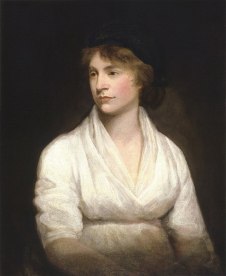
Her work was, not surprisingly, enormously controversial and even scandalous in its time, and Wollstonecraft’s unconventional life (she openly had sexual relationships, and a child, outside of marriage) was used as fodder for widespread disapprobation of her writing. And yet the Vindication lives on, and the women who followed her carried her message into their fight, on both sides of the Atlantic.
Margaret Fuller, a noted American Transcendentalist thinker, and a woman who also lived an unconventional life, acknowledged Wollstonecraft’s influence on her own manifesto, Woman in the Nineteenth Century (1845). And certainly Elizabeth Cady Stanton, Lucretia Mott, and other attendees of the Seneca Falls Convention in 1848, were channeling Wollstonecraft’s rethinking of Rousseau’s ideas when they wrote the Declaration of Sentiments and Resolutions, an intentionally obvious revision of the Declaration of Independence to include women in that seminal document of the country’s formation. The Declaration of Sentiments is generally considered the inciting document of the women’s suffrage movement in the United States.
Supported by centuries of argument by brave women shouting into the void, the real fight for women’s suffrage, in both England and America, began in earnest in the middle of the nineteenth century. Suffrage was not won, however, in either country, until the end of the second decade of the twentieth.
Madwomen in the Attic: The His-story of Hysteria
We need to pause here in our discussion of the movement for women’s suffrage and focus on how very brave the women who resisted convention truly were, and what they truly risked to speak out against the patriarchy in a world in which women were denied autonomy, let alone representation. Women had virtually no rights that were not mediated through the men in their lives, not even the most basic rights to their own bodies.
Speaking out in such a world—openly, publicly, challenging the status quo—was more than an invitation to scandal and judgment. A woman without a man supporting her endeavors—a man who, in his social and legal responsibility for her, could serve as a shield—risked her freedom and her very sanity. A woman who claimed a voice of her own and demanded it be heard could, for no other reason than her resistance, be declared mentally ill and treated for such against her will—including commitment for insanity (Pouba and Tianen). In such a case, a woman’s body became the battlefield itself.
The hysteria diagnosis is as old as the medical profession, and deeply rooted in women’s sexuality and men’s appropriation of it. In fact, the “treatment” of hysteria is even coded into Greek mythology. When the virgins of Argos fled, Melampus, a healer, “cured” their “madness” by directing them to have sex with virile men. And thus was orgasm deemed the cure for hysteria, and a woman’s assertion of her autonomy was linked for many centuries to insanity and the need for (heterosexual/heteronormative) sex.
In the intervening millennia, women, with virtually no recognized rights, could be, and often were, diagnosed, by men, with mental illness and committed to asylums for nothing more than not conforming strictly to the narrow space of behaviors deemed permissible. And when they were diagnosed with hysteria, a catch-all term that in effect meant nothing more than “not behaving properly,” one of the accepted treatments, since the Greeks, was so-called “pelvic manipulation”—i.e., forced orgasm.
 Comes the Vibrator: The Problematic Origin of B.O.B.
Comes the Vibrator: The Problematic Origin of B.O.B.
These days, the vibrator, in its vast array of interesting shapes and sizes, is a wonderful tool for sexual autonomy, play, and power, and modern discourse is full of memes and playful rhetoric about our “Battery Operated Boyfriends.” But its origin is not so full of pink sparkles.

The first vibrator was invented in 1880s England by Dr. J. Mortimer Granville, not for the pleasure of women but for his own ease. Manual pelvic manipulation was tiring for the doctor, and Granville was performing the “procedure” so often that it caused him chronic fatigue and pain in his hand and arm. He invented the device to save his time, strength, and energy.
Pelvic manipulation was frequently prescribed for women with a wide range of so-called maladies, and it’s true that the procedure was popular among many women of the Victorian and Edwardian eras, for whom sexual pleasure was supposed to be beneath their interest. And so, we have developed a lighthearted attitude about this element of women’s history. There are myriad examples in media and literature that find comedy in the idea of doctors’ waiting rooms crowded with women avidly awaiting their chance for “treatment.”
But that droll nostalgia doesn’t take into account the women who were diagnosed against their will, and forcibly “treated” with mechanical rape. In fact, the procedure’s apparent popularity became conflated with the idea of its success as a treatment, which strengthened the concept both of hysteria as a valid diagnosis and of “pelvic manipulation” as a valid medical treatment.
The end of the 19th century, as women’s dissatisfaction with their lot in the world crystallized into protest and resistance, was the high mark of hysteria diagnoses and its “treatments.” The women who banded together and fought most fiercely for their enfranchisement, who gave over polite rhetorical argument and did battle instead, understood what they risked—not only incarceration but commitment. Not only the constraint of their bodies but the forcible penetration of them.
That was their bravery—to risk their lives and bodies and minds in the fight for their voice.
As a sympathetic psychiatrist pointed out at the commitment hearing for Alice Paul, a hero of the American suffrage movement, “Courage in women is often mistaken for insanity.”
Nasty Women: The Final Front in the Suffrage Fight: 1905-1920.
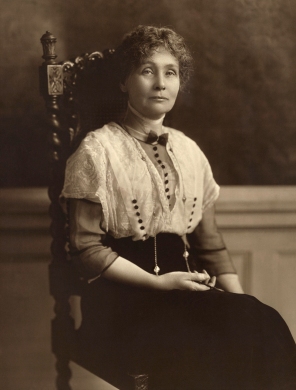
In Manchester, England, in 1903, Emmeline Pankhurst changed the face of the fight for women’s suffrage. Frustrated with the lack of progress in the cause, she formed the Women’s Social and Political Union, with the express purpose to radicalize the movement. The days of asking to be heard were over; it was time to demand the floor. Pankhurst shaped the WSPU with an overtly militaristic strategy. Though women had individually engaged in civil disobedience in support of suffrage for years, on both sides of the Atlantic—Susan B. Anthony was famously arrested for voting illegally in the United States—Pankhurst’s WSPU was the first time a significant organization promoted an explicit strategy of disruption and disobedience. They chained themselves to fences, lobbed bricks and rocks through windows, and even stormed Parliament to demand their rightful place.
The women of the WSPU began being arrested for their small acts of civil disobedience in 1905, and in response, they adopted the militaristic tactics of exiles from oppressive regimes. They learned how to conduct and survive a hunger strike from Russian exiles from tsarism (Grant), and they learned jiu-jitsu from one of their own, Edith Garrud, using it to protect themselves from police brutality during protests. Marion Wallace Dunlop engaged in the first hunger strike, in 1909. Following her example, it quickly became standard for imprisoned suffragettes to hunger strike immediately upon arrest—and to be force-fed in response.

Emmeline Pankhurst’s daughters, Sylvia and Christabel, were both active in the movement, and all three experienced imprisonment, hunger striking, and force-feeding. Sylvia described in clear detail the torture of feeding, making it clear that it, too, is a form of rape, a forcible, violent penetration of a woman’s body.
This was the world in which suffragettes fought, where they were treated with less humanity than murderers, because they were women, considered less than, refused any autonomy, and entirely subject to the will and demands of men.
And yet, upon release from Holloway Prison, suffragettes turned right around and picked up the banner again, volunteering for another turn on the cycle, knowing they risked imprisonment yet again, knowing they risked their lives and even their children. Imprisoned suffragettes were awarded medals by their sisters upon their first release, with new bands to place on them with every subsequent incarceration. It wasn’t unusual for a suffragette to earn four or more bands commemorating different incarcerations and hunger strikes.
Emily Davison, a particularly passionate suffragette, so militant that even the WPSU eventually set her aside, was force-fed 49 times before she died in 1913, when she jumped onto the track on Derby Day and was run down by the King’s racehorse. She held a suffrage banner in her hands.

A young American graduate student studying in England during the rise of the WPSU, Alice Paul was inspired to bring Pankhurst’s tactics to her own country. She faced resistance from the leaders of the American movement, women like Carrie Chapman Catt, who saw the events occurring in England, decided that militarism was doing more harm than good for the cause, and continued the strategy of diplomacy in the U.S.
But Paul had been on the ground in London and had seen the passion of the suffragettes there. She’d heard Pankhurst’s arguments for civil disobedience and militarism, she’d protested and been imprisoned there, and she argued that it was time for the same at home as well. Admiring Catt and the others who’d led the American movement for years, Paul tried to work within the National American Woman Suffrage Association, and Catt tried to accommodate the younger woman’s zeal, finding new ways for her to work within the organization. Finally, though, their visions were simply not compatible, and Paul broke with NAWSA to form the National Woman’s Party.
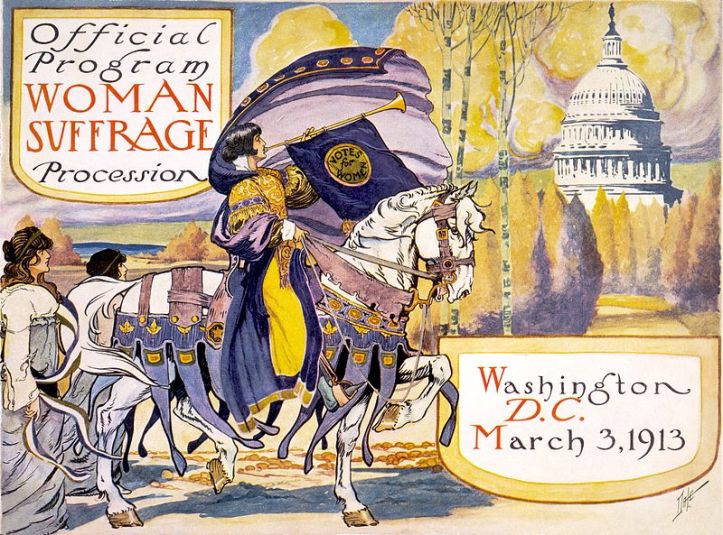
The schism between the diplomatic and disobedient arms of the American suffrage movement began in earnest in March 1913, and the Woman’s Suffrage Parade that took place in Washington, D.C., on the day before Woodrow Wilson’s inauguration (see photo, top). Suffragists from around the globe participated in the spectacular event, thousands of women and men marching in support of the enfranchisement of women. Its significance transcended the spectacle, however. A crush of spectators, comprised mostly of men, reacted violently against the march, and it marked the first event of wide-scale violence in the American movement.
The shocking images of marchers being beaten, and police largely standing by and letting it happen, began to turn the tide of public opinion. And certainly, it turned the tide of suffragist strategy. After the Women’s Parade, Alice Paul and her like-minded sisters adopted Pankhurst’s strategies of disruption and disobedience. They began by simply standing outside the White House, on the sidewalk, wearing their sashes and holding banners calling out President Wilson. And they were arrested—for blocking the road.
American institutions of power reacted as the British had. American suffragists were imprisoned, beaten, tortured, force-fed, and threatened with commitment to asylums—and sometimes actually committed.
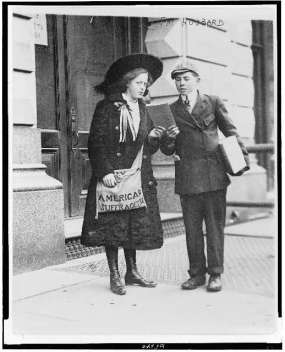
However, word of their plight, described in heart-wrenching detail in illicit letters written from prison and sneaked out past those walls, worked on public sentiment the way the images and story of the Women’s Parade did. In both England and America, the notion of women beaten and abused conflicted with the patriarchal, patronizing image of, and sense of responsibility for, the “fairer sex,” and the public finally began to be shocked for the women, not at them. The women’s courage and passion found a new light, and the public opinion about their cause began to shift in their favor.
Conclusion: The Victory of Voice, for Voice
As is always the case, this kind of change comes slowly, and even faced with the horrors of the suffrage fight, public opinion didn’t shift dramatically all at once. The fight waged in all its horrors for years before true victory was achieved. In England, women aged 30 and over gained the right to an equal vote in 1918 (they have just recently celebrated the centennial). Women aged 21 did not gain their voice for another ten years. In America, a vaster, more various country, and a federal republic, the change came gradually at first, with states and territories giving women the right to vote individually, starting with Wyoming (as a territory, women had the right to vote in Wyoming from 1869, and as a state from 1890). The 19th Amendment to the Constitution of the United States was ratified in August 1920, giving women aged 21 and older the right to an equal vote across all the United States.
If not for the brave, mighty warriors, the “iron jawed angels” who laid their bodies on the gears of the patriarchy, who risked their lives, their families, and their sanity, women might yet be silenced.
The right to vote should never be ignored or taken for granted, and should always be exercised with the weighty sense of all that was sacrificed for the chance to make our mark.
Sources
“Alice Paul.” National Women’s History Museum. Web. Accessed 4 February 2018. https://www.womenshistory.org/education-resources/biographies/alice-paul
“Carrie Chapman Catt.” National Women’s History Museum. Web. Accessed 5 February 2018. https://www.womenshistory.org/education-resources/biographies/carrie-chapman-catt
Castleman, Michael. “‘Hysteria’ and the Strange History of Vibrators.” Psychology Today. 01 March 2013. Web. Accessed 4 February 2018. https://www.psychologytoday.com/blog/all-about-sex/201303/hysteria-and-the-strange-history-vibrators
“Christine de Pizan (b. 1365-d. 1430).” Web. Accessed 4 February 2018 http://departments.kings.edu/womens_history/chrisdp.html
Cohen, Danielle. “This Day in History: The 1913 Women’s Suffrage Parade.” Obama White House Archives. 3 March 2016. Web. Accessed 5 February 2018. https://obamawhitehouse.archives.gov/blog/2016/03/03/this-day-history-1913-womens-suffrage-parade
“Declaration of Sentiments and Resolutions.” The Elizabeth Cady Stanton & Susan B. Anthony Papers Project. Web. Accessed 4 February 2018. http://ecssba.rutgers.edu/docs/seneca.html
Dismore, David. “Today in Herstory: Suffragist Alice Paul Kept in Hospital During Hunger Strike.” The Feminist Majority Foundation. 18 November 2014. Web. Accessed 5 February 2018. https://feminist.org/blog/index.php/2014/11/18/today-in-herstory-suffragist-alice-paul-kept-in-hospital-during-hunger-strike/
“Elizabeth Cady Stanton.” National Women’s History Museum. Web. Accessed 4 February 2018. https://www.nwhm.org/education-resources/biographies/elizabeth-cady-stanton
“Emily Davison.” Biography. Web. Accessed 5 February 2018. https://www.biography.com/people/emily-davison-9268327
“Emmeline Pankhurst.” BBC. Web. Accessed 5 February 2018. http://www.bbc.co.uk/history/historic_figures/pankhurst_emmeline.shtml
“Feminist Chronicles – 1968.” Feminist Majority Foundation. Web. Accessed 4 February 2018. http://www.feminist.org/research/chronicles/fc1968.html
Fuller Margaret. Woman in the Nineteenth Century. American Transcendentalism Web. Web. Accessed 4 February 2018. http://transcendentalism-legacy.tamu.edu/authors/fuller/woman1.html
Grant, Kevin. “British Suffragettes and the Russian Method of Hunger Strike.” Comparative Studies in Society and History 53.1 (2011): 113-43.
“House Moves for Woman Suffrage.” The New York Times 25 September 1917. Web. Accessed 5 February 2018. http://query.nytimes.com/mem/archive-free/pdf?res=9F0CE1D8103AE433A25756C2A96F9C946696D6CF
“Jean Jacques Rousseau.” Standford Encyclopedia of Philosophy. 26 May 2017. Web. Accessed 4 February 2018. https://plato.stanford.edu/entries/rousseau/
Lanctot, Catherine J. “‘We Are at War and You Should Not Bother the President’: The Suffrage Pickets and Freedom of Speech During World War I.” Working Paper Series. Villanova University, 2008. Web. Accessed 5 February 2018. https://digitalcommons.law.villanova.edu/cgi/viewcontent.cgi?referer=https://www.google.com/&httpsredir=1&article=1120&context=wps
Lennon, Joseph. “The Hunger Artist.” The Times Literary Supplement. 24 July 2009. Web. Accessed 5 February 2018. https://www.the-tls.co.uk/articles/private/the-hunger-artist/
“Lucretia Mott.” National Women’s History Museum. Web. Accessed 4 February 2018. https://www.nwhm.org/education-resources/biographies/lucretia-mott
“Mary Wollstonecraft.” Stanford Encyclopedia of Philosophy. 19 August 2016. Web. Accessed 4 February 2018. https://plato.stanford.edu/entries/wollstonecraft/
Meyers, Rebecca. “General History of Women’s Suffrage in Britain.” The Independent. 27 May 2013. Web. Accessed 5 February 2018. http://www.independent.co.uk/news/uk/home-news/general-history-of-women-s-suffrage-in-britain-8631733.html
Napikoski, Linda. “’The Second Feminist Wave: Martha Weinman Lear’s 1968 Article about the Feminist Movement.” ThoughtCo.com. 28 May 2017. Web. Accessed 4 February 2018. https://www.thoughtco.com/the-second-feminist-wave-3528923
“The National American Woman Suffrage Association.” Bryn Mawr Univeristy. Web. Accessed 5 February 2018. http://www.brynmawr.edu/library/exhibits/suffrage/nawsa.html
“National Woman’s Party. National Woman’s Party. Web Accessed 5 February 2018. http://nationalwomansparty.org/learn/national-womans-party/
The New Agenda. “‘Courage in women is often mistaken for insanity’—Women Get the Right to Vote.” 22 August 2010. Web. Accessed 4 February 2018. http://thenewagenda.net/2010/08/22/must-see-courage-in-women-is-often-mistaken-for-insanity-women-get-the-right-to-vote/
Onion, Rebecca. “A Suffragette Describes What It Felt Like to Be Force-Fed.” Slate. 17 July 2013. Web. Accessed 5 February 2018. http://www.slate.com/blogs/the_vault/2013/07/17/sylvia_pankhurst_the_suffragette_s_first_person_account_of_force_feeding.html
Pearson, Catherine. “Female Hysteria: 7 Crazy Things People Used to Believe about the Ladies’ Disease.” The Huffington Post. 21 November 2013. Web. Accessed 5 February 2018. https://www.huffingtonpost.com/2013/11/21/female-hysteria_n_4298060.html
Pouba, Katherine and Ashley Tianen. “Lunacy in the 19th Century: Women’s Admission to Asylums in United States of America.” Oshkosh Scholar 1 (2006): 95-103.
Rodriguez, Deanna. “Christine de Pizan: Her Works.” A Medieval Woman’s Companion: European Women’s Lives in the Middle Ages. Web. Accessed 4 February 2018. https://amedievalwomanscompanion.com/christine-de-pizan/
Ruz, Camila and Justin Parkinson. “‘Suffrajitsu’: How the Suffragettes Fought Back Using Martial Arts.” BBC News. 5 October 2015. Web. Accessed 5 February 2018. http://www.bbc.com/news/magazine-34425615
Salam, Maya. “When Susan B. Anthony’s ‘Little Band of 9 Ladies’ Voted Illegally.” The New York Times 5 November 2017. Web. Accessed 5 February 2018. https://www.nytimes.com/2017/11/05/us/womens-rights-suffrage-susan-b-anthony.html
Sanghani, Radhika. “ ‘Suffragettes lost husbands, children, and jobs’: The heavy price women paid.” The Telegraph. 12 October 2015. Web. Accessed 5 February 2018. http://www.telegraph.co.uk/women/life/suffragettes-lost-husbands-children-and-jobs-the-heavy-price-women-paid/
Sillah, Memunah. “On Woman in the Nineteenth Century.” American Transcendentalism Web. Web. Accessed 4 February 2018. http://transcendentalism-legacy.tamu.edu/authors/fuller/sillahonfuller.html
“Simone de Beauvoir.” The Standford Encyclopedia of Philosophy. 5 August 2014. Web. Accessed 4 February 2018. https://plato.stanford.edu/entries/beauvoir/
Sollee, Kristen. “6 Things to Know about 4th Wave Feminism.” Bustle. Web. Accessed 4 February 2018. https://www.bustle.com/articles/119524-6-things-to-know-about-4th-wave-feminism
“Sor Juana Inés de la Cruz.” Biography. Accessed 4 February 2018. https://www.biography.com/people/sor-juana-in%C3%A9s-de-la-cruz-38178
Stern, Marlow. “‘Hysteria and the Long, Strange History of the Vibrator.” The Daily Beast. 27 April 2012. Web. Accessed 4 February 2018. https://www.thedailybeast.com/hysteria-and-the-long-strange-history-of-the-vibrator
Takayanagi, Mari. “Parliament and Suffragettes.” Lecture. Web. Accessed 5 February 2018. https://www.parliament.uk/get-involved/education-programmes/universities-programme/university-teaching-resources/parliament-and-suffragettes/
Tasca, Cecilia, et al. “Women and Hysteria in the History of Mental Health.” Clinical Practice & Epidemiology in Mental Health 8 (2012): 110-119. https://www.ncbi.nlm.nih.gov/pmc/articles/PMC3480686/
Wild, Chris. “1800s: Victorian Vibrators.” Mashable. 20 February 2015. Web. Accessed 4 February 2018. https://mashable.com/2015/02/20/history-of-vibrators/#NDCCOEUFoOqL
Wojtczak, Helena. “The Women’s Social & Political Union.” The Victorian Web. Web. Accessed 5 February 2018. http://www.victorianweb.org/gender/wojtczak/wspu.html
“Woman’s Suffrage Timeline.” National Women’s History Museum. Web. Accessed 5 February 2018. https://www.nwhm.org/resources/timeline/womans-suffrage-timeline
“Women’s Social & Political Union (Suffragettes).” Spartacus Educational. Web. Accessed 5 February 2018. http://spartacus-educational.com/Wwspu.htm
“WSPU hunger strike force feeding medal.” A History of the World. Web. Accessed 5 February 2018. http://www.bbc.co.uk/ahistoryoftheworld/objects/SDveJgRgQy-U_MhY8bBlpA 
Susan Fanetti is an English professor at California State University, Sacramento, and an independent author. Her novel Nothing on Earth & Nothing in Heaven takes on the story of the fight for women’s suffrage in both England and the United States.

Very interesting, thank you. A couple of points.
1) Surely there were suffragists in England as well? I thought they were the late 19th century non-disobedience activists. The suffragettes were a little later, the militant ones.
2) There’s a film clip of Emily Davison at the Derby; this has been analysed recently. The feeling is that she was trying to attach her banner as a ‘petition’ to the King’s horse. Had she done so, and the King had met the horse after the race, she would have ‘presented a petition to the King’, and he could not refuse it.
LikeLiked by 1 person
Hi (I’m Susan, the writer of the post)! Thanks for your comment and your excellent points. You’re right that the term “suffragettes” came later. It was originally coined by a man and meant to disparage the women, but they claimed it for their own. I was focused on the point of the distinction, that “suffragettes” was a term English women of the cause used that American women did not. But I missed the chance to clarify its etymology and note that it wasn’t always the English term.
And I’ve seen that clip and read about the recent analyses of Davison’s final act. It’s been so controversial since she did it that I didn’t want to comment to directly on her motivations, but I love the thought that she was trying to present a petition to the King.
LikeLiked by 2 people
Thank you. If I had known that suffragette was a term of abuse, I’d sort of forgotten. Looking up the origin of the word in the UK, I found/remembered it was first used in the Daily Mail, a term of abuse as you say. In those days, the Daily Mail was a loathsome gutter tabloid. It went fascist in the 1930s. It is still a disgusting newspaper.
The film clip was analysed in a BBC documentary about Emily Davison. The original clip is grainy and rather blurry, unsurprisingly, and was ‘enhanced’. This certainly seemed to show her trying to attach the banner/scarf to the horse’s harness. The documentary mentioned a cheap day return ticket to the races, suggesting that she intended to protest but not to die. She was taken to the local cottage hospital; hospital is far too grand a term for what was little more than a few beds and a nurse or two. Whether she would have survived had she been taken to a decent facility is very uncertain.
LikeLiked by 1 person
Excellent post. Thank you for reminding us that the fight for equality is worth the cost.
LikeLiked by 2 people
Excellent précis of the very important Suffragettes and their contribution to modern life. Lest we forget!
LikeLiked by 1 person